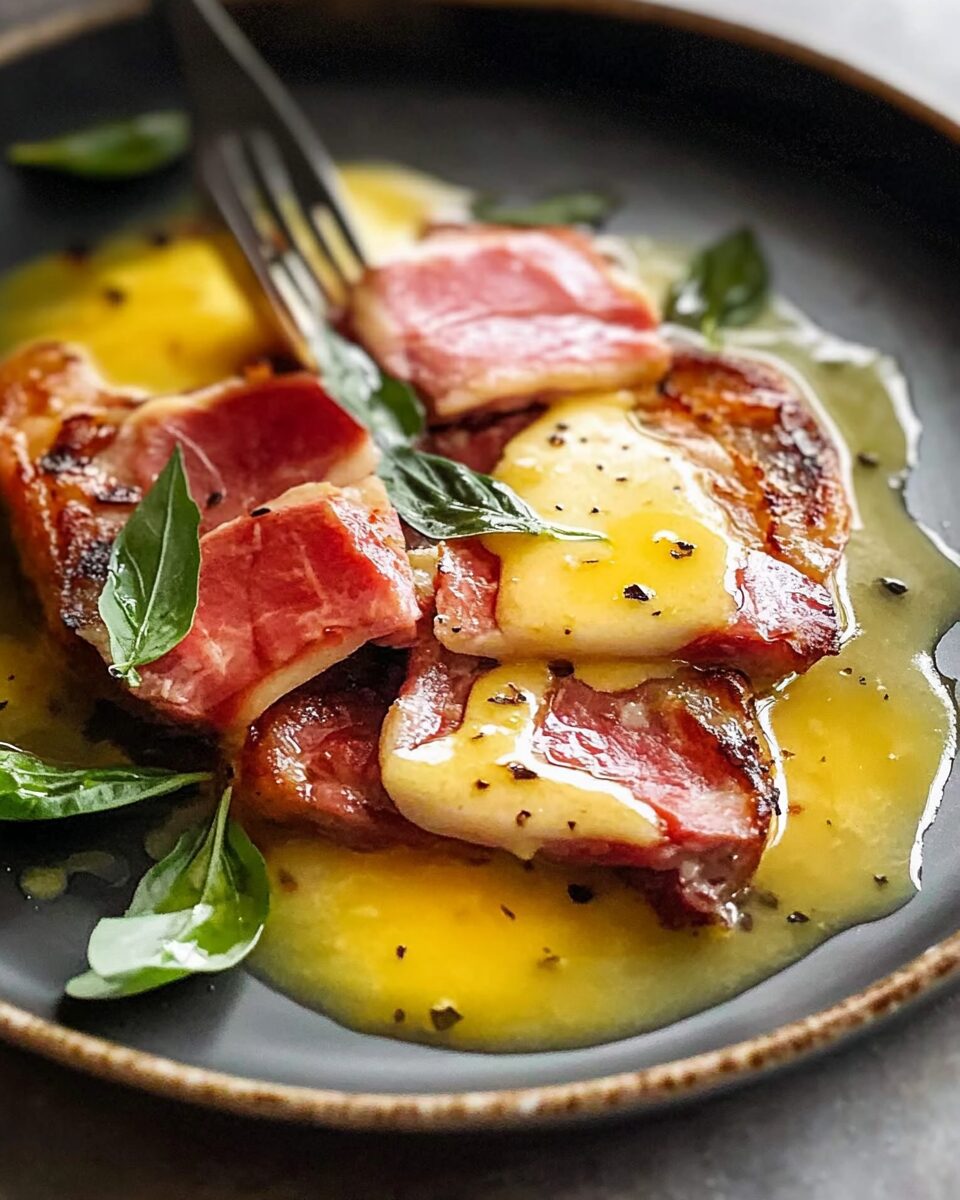Saltimbocca, a beloved Italian classic, is quick to prepare and utterly delightful. The crispy prosciutto wrapped around tender chicken cutlets pairs beautifully with fragrant sage and the velvety white wine butter sauce. This dish brings rustic Italian charm to the dinner table with minimal effort.
Perfect for a weeknight meal or a special occasion, Chicken Saltimbocca offers a rich combination of flavors. Serve it with mashed potatoes, polenta, or a side salad for a complete, comforting dish. It’s bound to impress even the toughest critics with its simplicity and elegance.
Full Recipe:
- 1 large chicken breast (sliced in half horizontally)
- 4 large sage leaves
- 4 slices of prosciutto
- 2 tbsp olive oil
- 2 tbsp all-purpose flour
- 1/4 tsp black pepper
- 1/4 cup white wine (Pinot Grigio or Chardonnay)
- 50g cold unsalted butter, cubed
- Small pinch of salt
Directions:
- Pound the chicken breasts to 0.5 cm thickness using a mallet or rolling pin. Cut each in half, so you have 4 pieces.
- Season each piece with black pepper. Fold a slice of prosciutto in half and place it on top of each chicken piece. Place a sage leaf on top and secure with a toothpick.
- Dust the non-prosciutto side of each chicken piece in flour, shaking off excess.
- Heat olive oil in a large skillet over medium-high heat. Cook the chicken, prosciutto-side down, for 90 seconds until golden, then flip and cook the other side for 1 minute.
- Remove the chicken from the skillet and set aside.
- Discard excess oil from the skillet but do not clean the pan. Add the white wine, and let it simmer for 30 seconds, scraping up any browned bits from the pan.
- Turn off the heat and add cold butter cubes to the pan, swirling gently until the butter melts and thickens the sauce.
- Serve the chicken with the sauce drizzled over it. Be careful of the toothpicks while eating!
Prep Time: 10 minutes | Cooking Time: 5 minutes | Total Time: 15 minutes
Kcal: 492 kcal | Servings: 2 servings
Chicken Saltimbocca: A Classic Italian Dish with Modern Appeal
Saltimbocca, meaning “jump in the mouth” in Italian, is a traditional Roman dish known for its simplicity, elegance, and irresistible combination of flavors. Traditionally made with veal, this dish has evolved to feature chicken as a popular alternative, especially in modern kitchens where chicken is more readily available and often preferred for its lean protein and accessibility.
The dish is a staple in many Italian restaurants and is beloved by home cooks due to its quick preparation and decadent taste. The pairing of thinly pounded meat, crispy prosciutto, and fresh sage leaves creates an explosion of flavor with every bite. When topped with a silky white wine butter sauce, it transforms into a gourmet meal with minimal effort.
A Brief History of Saltimbocca
Saltimbocca is believed to have originated in Rome, though variations of the dish can be found throughout Italy, particularly in regions like Lombardy and Venice. Historically, it was made with veal, which was considered a luxurious ingredient, symbolizing special occasions and wealth. The dish is thought to have made its way across the Italian peninsula due to its fast preparation and reliance on simple, fresh ingredients—qualities emblematic of Italian cuisine.
While the exact origins of Saltimbocca remain a topic of debate, it’s widely accepted as a staple of Italian cooking, celebrated for its balance of texture and taste. Over the years, cooks around the world have adapted the recipe to include more accessible proteins like chicken and pork, making it a household favorite far beyond Italy’s borders.
Why Chicken Saltimbocca Works So Well
Chicken Saltimbocca is a testament to how a few key ingredients can come together to create something extraordinary. Here’s why this dish is a triumph in any kitchen:
- Flavorful simplicity: Chicken Saltimbocca relies on just a handful of ingredients—chicken, prosciutto, sage, white wine, and butter—yet the depth of flavor it achieves is remarkable. The crispy prosciutto adds saltiness and texture, while the sage brings a unique earthy aroma that complements the meat perfectly.
- Quick cooking time: Chicken is a protein that cooks quickly, and when pounded thin for Saltimbocca, it can be ready in just minutes. This makes the dish an excellent choice for busy weeknights or when you’re looking to impress without spending hours in the kitchen.
- A decadent sauce: The white wine butter sauce is a simple reduction that enhances the dish without overpowering it. The sauce clings to the chicken, adding a luxurious texture and flavor with every bite. It’s a perfect example of how Italian cuisine can elevate basic ingredients into something indulgent.
- Versatility: While traditionally served with veal, Saltimbocca can be made with various proteins, including pork or beef. Chicken, however, has become the favored option for home cooks due to its mild flavor and ease of preparation. Chicken Saltimbocca pairs well with a variety of side dishes, from creamy mashed potatoes to sautéed vegetables, making it a versatile addition to any meal plan.
Modern Takes on a Traditional Recipe
Like many classic dishes, Saltimbocca has been adapted in countless ways to suit modern tastes and dietary preferences. While the core ingredients remain consistent, here are some common variations and twists on the traditional recipe:
- Pork or Beef Saltimbocca: In regions where veal is harder to come by, cooks often substitute pork or beef for the traditional cut. Pork tenderloin or thinly sliced beef steaks can be used in the same way as chicken, though each protein brings its own unique texture and flavor to the dish.
- Vegetarian Saltimbocca: For those who follow a plant-based diet, there are creative ways to adapt Saltimbocca. Thin slices of eggplant or zucchini can replace the meat, while plant-based prosciutto or smoked tofu can mimic the salty, savory notes of traditional prosciutto. The key is in the pairing of fresh sage and a rich sauce to achieve a similar flavor profile.
- Wine Variations: While white wine, especially Italian Pinot Grigio or Chardonnay, is the traditional choice for the sauce, some modern versions use Marsala wine, which adds a sweeter, more intense flavor. Sparkling wines or even non-alcoholic alternatives like chicken broth can also be used for those who prefer to avoid alcohol in their cooking.
Serving Suggestions and Accompaniments
One of the reasons Chicken Saltimbocca has gained popularity is its versatility in terms of how it can be served. Depending on the occasion, it can be presented as a rustic, hearty meal or a refined, elegant dish. Here are a few serving ideas:
- Starchy bases: Saltimbocca is often served over a starchy base to soak up the delicious sauce. Mashed potatoes are a classic choice, offering a creamy contrast to the crispy prosciutto and tender chicken. Polenta is another excellent option, especially if you’re aiming for a more authentic Italian presentation.
- Vegetable sides: To balance the richness of the dish, pair Chicken Saltimbocca with simple, sautéed vegetables such as green beans, spinach, or asparagus. A fresh side salad with a tangy vinaigrette can also help cut through the buttery sauce, adding a refreshing contrast to the meal.
- Bread for mopping up the sauce: Italian meals are often incomplete without a crusty loaf of bread, and Saltimbocca is no exception. Serve it with a baguette or ciabatta to mop up every last bit of the white wine butter sauce.
- Pairing with wine: Since the sauce is made with white wine, it’s only fitting to serve the dish with a glass of the same wine. A crisp, dry Pinot Grigio or a lightly oaked Chardonnay pairs beautifully with the flavors of the chicken and prosciutto, elevating the dining experience.
Tips for the Perfect Chicken Saltimbocca
While Chicken Saltimbocca is a relatively simple dish, there are a few tips and tricks to ensure that your version turns out perfectly every time:
- Pound the chicken evenly: One of the keys to this dish is ensuring that the chicken breasts are pounded to an even thickness. This ensures that they cook uniformly and quickly, avoiding overcooked edges or undercooked centers.
- Use cold butter for the sauce: When making the white wine butter sauce, it’s important to use cold butter, which helps thicken the sauce and gives it a luxurious texture. If the butter is too warm when added, the sauce may turn out too thin or oily.
- Don’t skimp on the prosciutto: The prosciutto is an essential part of Saltimbocca’s flavor, adding both saltiness and texture. Be sure to use good-quality prosciutto, and don’t be afraid to be generous with it!
- Rest the chicken: After cooking the chicken, let it rest for a minute or two before serving. This allows the juices to redistribute, ensuring a moist and tender final dish.
Health Benefits of Chicken Saltimbocca
Despite its rich, indulgent flavors, Chicken Saltimbocca can actually be a relatively healthy option when enjoyed in moderation. Here’s why:
- Lean protein: Chicken is a great source of lean protein, which is essential for muscle repair and overall health. It’s lower in fat compared to other meats like beef or pork, making it a lighter choice.
- Healthy fats: While the dish does use butter, the amount is relatively modest, and olive oil is also used in cooking. Olive oil is rich in monounsaturated fats, which are beneficial for heart health.
- Moderate calorie content: With around 492 calories per serving, Chicken Saltimbocca is a satisfying meal that fits well into a balanced diet. Pair it with plenty of vegetables to add fiber and nutrients to your meal.
Conclusion: Why Chicken Saltimbocca Deserves a Place in Your Recipe Rotation
Chicken Saltimbocca is a dish that delivers on both flavor and convenience, making it a standout in the realm of Italian cuisine. Its combination of crispy prosciutto, fragrant sage, and silky white wine butter sauce creates a gourmet experience that is surprisingly easy to prepare. Whether you’re hosting a dinner party or simply want to elevate your weeknight meals, this dish is sure to impress.
In conclusion, Chicken Saltimbocca is more than just a meal; it’s a celebration of simple, high-quality ingredients coming together to create something extraordinary. Its versatility allows for endless variations, and it pairs beautifully with a wide range of sides, making it suitable for any occasion. Try it once, and you’ll likely find yourself adding it to your regular meal rotation.





